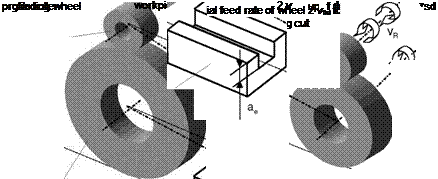Working with materials that are hard to machine generally causes problems with respect to the lifetimes of the grinding wheels used and thus with respect to the performance of the grinding process. Large amounts of grinding wheel stress lead to increased grain breakaway, especially in the case of conventional grinding wheels. Grinding wheel wear, which appears in a short amount of time, leads to impermissible shape deviations in the grinding wheel and thus in the workpiece to be machined.
![]() ds= 400 mm workpiece material
ds= 400 mm workpiece material
S 6-3-2 (64 HRC)
grinding parameters
ext. cylindrical plunge grinding
Q’w = 23 mm3/mms vs = 90 m/s
 |
|
One method which is especially suitable for grinding materials that are hard to machine with high material removal rates in creep feed grinding is grinding with continuous dressing (CD) [ARCI91, HOFF96].
The conventional grinding wheels here utilised are constantly dressed during the grinding process with a diamond profile roller which is at least as broad as the grinding wheel. In this way, the shape of the grinding wheel is constantly regenerated, i. e. a high level of accuracy can be realised in the profile. Furthermore, new sharp grits are constantly exposed as the dressing progresses, promoting high material removal rates [PEAR79, SALJ84].
The dressing process constantly lowers the grinding wheel diameter due to the continuous feed movement of the dressing roller. In order to obtain a plane — parallel workpiece surface in flat grinding as shown in Fig. 6-15, the reduction of
 |
the diameter of the grinding wheel can be compensated accordingly. The prerequisite for this is a precise control of the spindle and the dressing roller feed [UHLM82].
Fig. 6-15. The depth of dressing cut in continuous dressing
In the case of conventional creep feed grinding, the obtainable specific material removal rate depends heavily on the machined material volume, since, with increasing material removal rates, grinding wheel sharpness decreases from wear. Because of this, the maximum material removal rate becomes much lower. In the case of CD grinding on the other hand, due to the constant dressing of the grinding wheel during the machining process, the material removal rate is only depending on the dressable grinding wheel volume.
A variation of CD grinding is discontinuous CD grinding. In this case, the grinding tool is dressed during grinding, but not continuously, but rather after certain time intervals.
CD grinding competes in certain application cases with creep feed grinding with cBN grinding wheels. Which method and which abrasive is the most economical has to be determined with the help of profitability calculations for each particular case. Due to the high costs of the diamond dressing roller, which can only produce a certain grinding wheel shape respectively, grinding with continuous dressing is used almost exclusively in large-batch and mass production.
